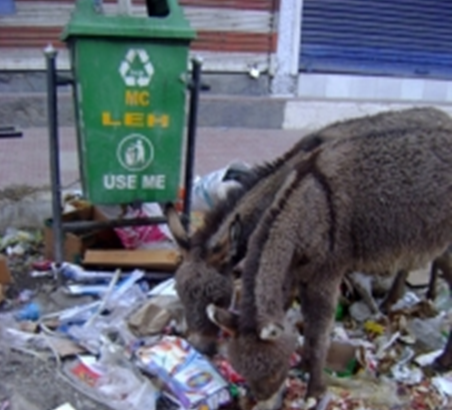Donkeys: India
m (Pdewan moved page Dying Donkeys of Ladakh to Donkeys of Ladakh) |
|||
| Line 9: | Line 9: | ||
|} | |} | ||
| − | [[Category: | + | [[Category:India|D]] |
| − | [[Category: Fauna | + | [[Category:Fauna|D]] |
[[Category: Places |Alphabet]] | [[Category: Places |Alphabet]] | ||
[[Category:Name|Alphabet]] | [[Category:Name|Alphabet]] | ||
Revision as of 18:32, 29 December 2013
This is a collection of articles archived for the excellence of their content. Readers will be able to edit existing articles and post new articles directly |
Dying Donkeys of Ladakh
Dying Donkeys of Ladakh: Where is Our Conscience
By Angela Munsel Paljor, Thursday, July 4, 2013
Leh: Donkeys have been used as domesticated animals for the past 5000 years all over the world. Almost 96% out of the 41 million donkeys are in developing and underdeveloped countries. The durability and longevity of donkeys have allowed donkeys to be used for draught work in transportation and agricultural activities over thousand of years. They are considered to be the cheapest form of agriculture power after humans. They are also used for riding, threshing, milling and other works. Historically, donkeys have played a key role in land cultivation and transportation of goods. They have been used in carrying loads as well as manure to the fields before the spring season (bung ludh), and they would be busy in the threshing fields (halo baldur) after the harvest season.
With the increasing mechanization of farming and other labor associated with the land over the years, donkeys have lost their importance as valuable domestic animals in Ladakh. Ladakhis have been treating their donkeys with such apathy that foreigners have been compelled to create a sanctuary for stray donkeys. Due to the seasonal nature of the agriculture industry, people use their donkeys at sowing and harvesting times and either lock them in sheds for days without proper nourishment or leave them to wander around streets or other people’s fields.
In the former case it leads to the undernourishment of the animals, which is awful; while in the latter case, they constantly become prey to animals like dogs and wolves. In Shey village, it is appalling how villagers have gotten used to seeing donkeys lying dead because of the frequency of such encounters. These days, donkeys are hardly used for agricultural purposes as modern tractors or threshers do their work more efficiently. This has led to villagers becoming careless and indifferent as to the whereabouts of their donkeys. It is disappointing to see people behave in such inhumane and selfish ways. In certain cases, dead donkeys are left to rot in the fields or along side the roads for days while the stray dogs feast on them.
The horrendous nature of our people is in full display in the early morning’s right in the main market of Leh. Not only are our people inhumane but in so many ways lack basic civic sense. The main market street turns into parking areas for cows and donkeys as they herd towards roadsides that are scattered with filth created by pedestrians, shopkeepers and restaurateurs. If Leh can become a hub for people from everywhere to acquire education and jobs then why can’t our people behave by not littering the streets? When we do have appropriate means of disposing wastes and regular MCL trucks coming right outside our houses, why do we still persist on strewing garbage around trash-bins instead of making sure the rubbish goes inside the bins? It has become our very nature to play the “blame game,” in which, if someone points out our mistakes, the rest of us come up with numerous excuses.
Back in the day, people in Ladakh used to live together with their animals under one roof for reasons such as poverty, but still the people were kind to their animals and treated them well. The condition of farm and other domestic animals was most probably a lot better back then compared to the present day Ladakh, where people have become so self-centered that even the death of an innocent animal does not have any effect on them.
Adding to that, at certain hours one can see people coming out of fancy cars carrying huge bags filled with garbage to throw them on deserted roads. However, people have grown accustomed to putting the blame on tourism for all the pollution and forgetting their own responsibilities towards their land. If people, in their attempts to keep their own area clean do not hesitate to destroy the other person’s surroundings, how we can expect them to look after animals like donkeys, which are of no use to them? Although donkeys are not indispensable, they are still a part of our past culture and traditions. To this day, our grandparents recall and share fond memories of seasonal occasions like the “bung ludh” and “halo baldur”. If we can still wear Gonchas and appreciate old monuments, then how is it so difficult to feed and look after living beings that were an integral part of our culture?
